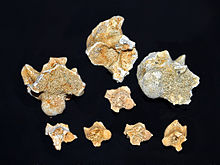Palaeophis
|
Palaeophis Temporal range: Cretaceous - Eocene |
|
|---|---|
 |
|
| Fossil vertebrae of Palaeophis maghrebianus from Khouribga (Morocco) | |
| Scientific classification | |
| Kingdom: | Animalia |
| Phylum: | Chordata |
| Class: | Reptilia |
| Order: | Squamata |
| Suborder: | Serpentes |
| Family: | †Palaeophiidae |
| Subfamily: | †Palaeopheinae |
| Genus: |
†Palaeophis Owen, 1841 |
Palaeophis ('ancient snake') is an extinct genus of marine snake that is the type genus of the extinct snake family Palaeophiidae.
Species within this genus lived from the Cretaceous period to the Eocene epoch, approximately from 70.6 to 33.9 million years ago. Fossils of species within this genus have been found in England, France, Denmark,Morocco and Mali.
Species within this genus include:
These species varied broadly in size; Palaeophis casei is the smallest at 1.3 metres of length, while Palaeophis colossaeus, known from a single vertebra, is the largest at the estimated size limits for the genus at over 9 m (29.5 ft) in length, making it one of the largest known snakes. However most species of the genus were not as big.
Species of Palaeophis were specialised aquatic animals, as their fossils occur primarily in marine strata, though at least some estuarine remains have also been found. Different species are thought to have occupied different ecological niches.
Studies on Palaeophis vertebrae show a high degree of vascularisation, suggesting that it had a considerably faster metabolism and growth rate than modern snakes. This may suggest that palaeophiids, like other marine reptiles such as mosasaurs, might had developed towards endothermy.
...
Wikipedia
